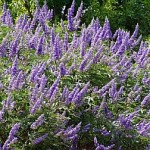San Antonio Express News
Gardening, ETC.
Sunday, June 4, 2006
By David Rodriguez
- Texas Lilac (Photos: aggie-horticulture.tamu.edu)
- Texas Lilac (Photos: aggie-horticulture.tamu.edu)

Are you looking for a plant that does well here in the South and mimics the lilacs that grow up north? That plant would be the Texas Lilac Vitex. This is where the work of the SuperStar horticulturists begins. The uniqueness of the Texas Superstar plant program is that Texas A&M horticulturists discover and develop the unique characteristics of otherwise well-known plants and make them even more desirable and marketable to the gardening public.
Texas Lilac Vitex is also known as Mexican lavender, lilac chaste tree, hemp tree, sage tree, monk’s pepper, Indian spice or Vitex. It is a native of China and India, although long ago it became naturalized throughout certain areas of the United States. Records indicate that Vitex has been cultivated in the U.S. since 1670.
For those of you who want a medicinal plant for a SuperStar, Vitex fills the bill. Vitex agnus-castus belonged to the official medicinal plants of antiquity and is mentioned in the works of Hippocrates, Dioscorides and Theophrast. Also, the common name “Monk’s Pepper” refers to the medieval belief that utilizing potions made from the berries helped monks maintain their vows of chastity.
Vitex grows best when planted in full sun and in a location that drains well. It will grow well in all areas of Texas, in both acid and alkaline soils. It prospers in hot and dry environments. The Texas Department of Transportation recognizes its toughness, and plants Vitex in highway medians. It is a spectacular butterfly-attracting plant and is deer resistant in that deer will not eat it, although they can damage it with their antlers if it is allowed to grow very large.
The older selections of Vitex had small spikes of flowers which were pale lilac, mauve, off-white or light pink. The blooms were small and, for the most part, unattractive. Horticulturists now have identified and tested improved selections such as “Montrose Purple,” “LeCompte,” and “Shoal Creek” which have spikes as long as 8 to 12 inches. All of these selections will be marketed under the name of Texas Lilac Vitex.
The bloom spikes on these improved selections are not only large and beautiful; they also are fragrant and provide long-lasting cut flowers. However, after the bloom spikes have provided several weeks of spectacular beauty, many aromatic black or dark-brown seeds are produced. Not only do these seeds prevent a profusion of additional bloom spikes, they may, in some regions of the state, produce a seedling population that will not have the same characteristics as the original plant and become a nuisance.
The obvious answer to this problem of seed production and resulting reduction of blooms is to promptly cut off or deadhead the spent bloom spikes after the first flowering so that the shrub will bloom again. So, if the answer is so simple, why haven’t people been doing it for the last 100 years? The problem is how rapidly the Vitex grow.
Because of the growing conditions in much of Texas, many perennials are best used as annuals, and many shrubs or small trees are best used as perennials. This has been the case with the three very successful Texas SuperStars – firebush, esperanza and perennial hibiscus. In most areas of Texas, firebush and perennial hibiscus die to the ground every winter. Esperanza-and now Texas Lilac Vitex- should be cut to the ground every winter to keep the plant manageable from season-to-season.
Depending on weather and cultural conditions (fertilizer, water, region of the state, etc.), plants will bloom again within six weeks of seed pod/stalk removal. It is best to remove the seed pods before they harden-the sooner after the bloom petals drop, the better, and the faster the plant will come back into bloom.
To annually maintain the plant in a desirable size range of six feet, plants should be cut within a few inches of the ground every winter. It will sprout and bloom by June if cut to the ground in winter. If the plant has gotten large during the previous growing season, you can use a small chain saw to cut them back and then use hedge shears to deadhead them during the growing season. Cutting the plants back will make the spikes much longer but, of course, there will be fewer of them (at least with the initial cut-down)-very similar to the thinning of fruit crops to produce larger, high-quality fruit. To stimulate rapid re-blooming and larger flower spikes, three pounds of a slow-release formulation of lawn fertilizer (19-5-9) per 100 square feet should be scattered around each plant after spent blooms have been removed.
The butterfly craze has created a new interest in growing the ultimate nectar plant known as buddleia or butterfly bush. Unfortunately, the majority of buddleias do not perform well in most areas of Texas and are not reliable perennials. However, the Texas Lilac Vitex can become the “buddleia” of Texas if handled properly.
So, whether you want to stimulate the presence of butterflies in your backyard with a drought-tolerant, pest-resistant plant, or whether you want to try some ancient herbal remedies, the new Texas Lilac Vitex is the plant for you. Check it out!
Remember, Learn and Have Fun!
Special Event: Do you want to learn about growing citrus in San Antonio? Come visit Dr. Jerry Parsons on Thursday, June 8 at the Schultze House Brown Bag Lunch program at 12 noon in downtown HemisFair Park, 514 HemisFair Plaza. Have fun touring the cottage gardens too.
David Rodriguez is the County Extension Agent-Horticulture for Bexar County. He represents Texas Cooperative Extension with the Texas A&M University System. For any landscape or gardening information, call the Bexar County Master Gardeners Hotline@ at (210) 467-6575, email questions to mg-bexar@tamu.edu, or visit our County Extension website at http:bexar-tx.tamu.edu

